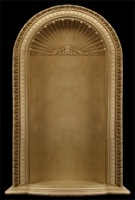Niche
Origin
French niche recess for a statue, vaulted recess, animal's lair
The word derives from the Latin nidus or nest, via the French niche. The Italian nicchio for a sea-shell may also be involved, as the traditional decoration for the top of a niche is a scallop shell, as in the illustration, hence also the alternative term of "conch" for a semi-dome, usually reserved for larger exedra.
Definitions
- 1: A shallow ornamental recess or hollow set into a wall, usually for the purpose of containing a statue or other decorative object.
- 2: A natural recess in a rock, hill, etc.
- 3: The hole, lair, etc., of an animal. More generally: a place of retreat or refuge.
- 4: A place or position suited to or intended for the character, capabilities, status, etc., of a person or thing.
- 5: The actual or potential position of an organism within a particular ecosystem, as determined by its biological role together with the set of environmental conditions under which it lives.
- 6: A position from which an entrepreneur seeks to exploit a shortcoming or an opportunity in an economy, market, etc.; (hence) a specialized market for a product or service.
Description
A niche in classical architecture is an exedra or an apse that has been reduced in size, retaining the half-dome heading usual for an apse. Nero's Domus Aurea (AD 64–69) was the first semi-private dwelling that possessed rooms that were given richly varied floor plans, shaped with niches and exedras; sheathed in dazzling polished white marble, such curved surfaces concentrated or dispersed the daylight.[1]
